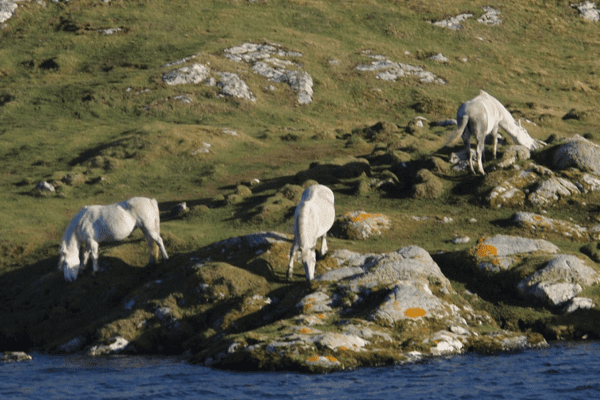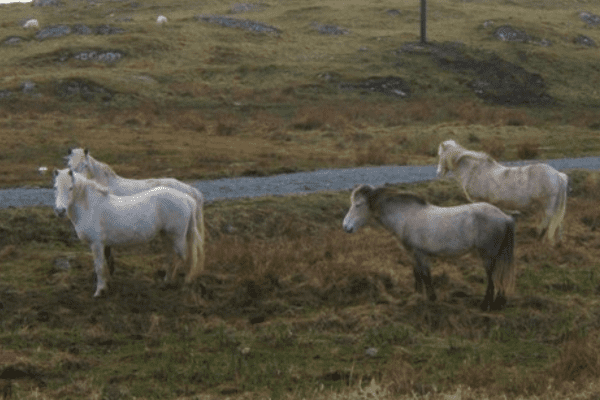The Eriskay Pony, a venerable equine breed native to Scotland, stands as a testament to nature’s adaptability and strength. Characterized by its predominantly grey hue, this pony boasts a dense, waterproof coat, a natural defense against the formidable Scottish climates. Esteemed for its versatility, the Eriskay excels in light draught tasks, is an ideal companion for young riders, performs admirably in diverse equestrian disciplines, and demonstrates proficiency in carriage driving.
The breed’s current status, deemed critical by the Rare Breeds Survival Trust, underscores the imperative need to safeguard this unique and historically significant breed for future generations.
History:
The Eriskay Pony has an extraordinary history reminiscent of its home island of Scotland: Hebrides. It has witnessed both change and adaptation through time. This breed’s story can provide insight into Scotland’s rich cultural and ecological fabric while offering glimpses into human-horse relationships that endure today.
Ancient Origins:
The Eriskay Pony can trace its lineage back millennia, with Celtic and Norse heritage playing significant roles. Their lineage can be seen through their similarity to equines depicted on Pictish stones across north and west Scotland – further supporting this claim that these ponies have long been part of Scottish landscape.
Geographical Ties:
The breed’s name, Eriskay, hails from a small island off of Scotland known as Eriskay. Here, their roots formed hardy and adaptable horses.
Historical Role:
Eriskay Ponies were long a part of western Scottish island communities, serving as crofters’ ponies, pack animals, and mounts for children – testament to their versatility and dependability.
Impact of Crossbreeding:
The 19th century witnessed massive changes, with widespread crossbreeding to produce larger ponies suitable for draught work. Eriskays were interbred with other breeds such as Arabs and Clydesdales to reduce purebred populations considerably.
Conservation Initiatives:
By the early 1970s, Eriskay’s population had shrunk to just 20 purebred animals due to mechanization; however, due to its isolation on Eriskay, some pure specimens survived on Eriskay.
Cultural Significance:
Eriskay Ponies became historically notable during the 1941 incident of SS Politician when islanders utilized them to transport salvaged whisky cargo back home. This event showcased their strength and resilience.
Current Status:
Unfortunately, Eriskay Ponies are now considered critically endangered with less than 300 breeding females worldwide and efforts underway to conserve this unique breed.
Preservation Societies:
The Eriskay Pony Society was founded in 1995 while Comann Each nan Eilean – The Eriskay Pony Society began operations in 2002 to conserve this species of pony. These societies maintain studbooks dating back to 1972 records with an aim of maintaining genetic purity while minimizing inbreeding.
Innovative Breeding Programs:
These societies collaborate with the Rare Breeds Survival Trust, using SPARKS (Single Population Analysis Records Keeping System) to identify genetically compatible breeding pairs.
A Living Legacy:
Eriskay Ponies on Holy Isle have become part of its living legacy since they were introduced there in the 1970s, managed by Samye Buddhist Centre without human interference or interference from any external force. These wild herds, introduced during this era, represent an exceptional part of Eriskay Pony history – living freely as their ancestors did for over 300 years before them.
Overall, the Eriskay Pony’s history is more than simply an account of an equine breed; rather it serves as an illustration of cultural resilience, environmental adaptation, and conservation efforts. One of the last representative Hebridean ponies, its journey from ancient times until today shows why rare and culturally important breeds need to be preserved for future generations.


Characteristics:
The Eriskay Pony is an exquisite breed known for its remarkable characteristics that epitomize both grace and resilience in an equine form. Hailing from Scotland’s rugged landscapes, this breed displays unique physical attributes and temperament traits which reflect its adaptability in challenging environments and fulfilling various roles.
Stature and Build:
Standing between 12 to 13.2 hands (48 to 54 inches, 122-137 cm), Eriskay Ponies are known for their compact strength. Their smaller stature makes them accessible and manageable for younger or less experienced riders.
Color and Markings:
While Eriskays tend to have grey as their main hue, other hues including bay and black can also be seen. Darker ponies often display pangare features with lighter muzzles and eye rings giving each pony its unique appearance.
Breed standards established by Robert Beck MRCVS BVMS of Comann Each nan Eilean – The Eriskay Pony Society promote the preservation of these traditional colors by restricting chestnut, piebald, skewbald or excessive white markings from becoming part of their appearance.
Adaptation to Climate:
To cope with Scotland’s harsh weather conditions, Eriskays have evolved with thick winter coats made of waterproof material as well as strong mane and tail hair – features that not only show their resilience, but are essential to their survival in such conditions.
Anatomy:
The breed’s anatomy includes a large head with wide forehead, signifying intelligence and alertness. A muscular neck and shoulders lead into a deep yet not overly broad chest. Long rib-cage and short loins increase back strength necessary for traditional roles while its slight slope adds balance to its overall balance physique.
Temperament and Versatility:
Eriskay Ponies are known for their laidback and friendly demeanor, making them great options for children as they exemplify patience and gentleness. Furthermore, this makes them suitable for various equestrian disciplines.
Equestrian Disciplines:
The breed excels at light draught work, dressage, show jumping, three-day eventing, western riding and driving – making their mark internationally in events like combined driving competitions held under the Federation Equestre Internationale’s auspices.
Therapeutic Role:
Eriskays are widely revered horses when it comes to therapeutic horse-riding programs, providing comfort and support to those in need of therapy and rehabilitation services. Their gentle temperaments and intuitive natures make them valuable partners.
The Eriskay Pony represents versatility, resilience and gentleness. With its distinctive combination of physical and temperamental traits – making it one of the most highly prized breeds in equestrian sport as well as historical and cultural significance – its adaptability has allowed the Eriskay to survive the harsh climates of Scotland Hebrides as well as today’s demands in sports equitation therapy equine sports programs and therapy settings, illustrating its remarkable nature.
Temperament and Abilities:
Eriskay Ponies are known for their intelligent, gentle yet energetic natures. These horses exhibit impressive agility and sure-footedness thanks to the rugged terrain in their home country of Eriskay.
Traditionally these ponies were employed for tasks such as seaweed collection and transportation – they now enjoy driving duties, light draft work, riding lessons for children as well as smaller adults thanks to their kind disposition.


Conservation Efforts:
Eriskay Ponies were threatened with extinction during the mid-20th century due to crossbreeding and decreasing demand for small working horses, prompting several local and international preservation societies dedicated to safeguarding and promoting this unique breed.
Conservation efforts focus on maintaining genetic purity while emphasizing its individual qualities.
Cultural Impact:
Eriskay Ponies hold a special place in Scottish culture and folklore. They are celebrated in local tales and songs, embodying the spirit of the Hebrides. The breed’s survival and revival are seen as symbols of Scottish resilience and pride in heritage.

